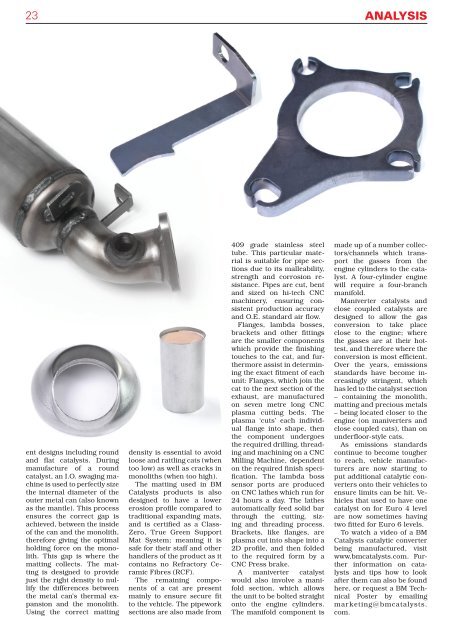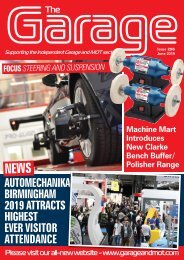Create successful ePaper yourself
Turn your PDF publications into a flip-book with our unique Google optimized e-Paper software.
23<br />
ANALYSIS<br />
ent designs including round<br />
and flat catalysts. During<br />
manufacture of a round<br />
catalyst, an I.O. swaging machine<br />
is used to perfectly size<br />
the internal diameter of the<br />
outer metal can (also known<br />
as the mantle). This process<br />
ensures the correct gap is<br />
achieved, between the inside<br />
of the can and the monolith,<br />
therefore giving the optimal<br />
holding force on the monolith.<br />
This gap is where the<br />
matting collects. <strong>The</strong> matting<br />
is designed to provide<br />
just the right density to nullify<br />
the differences between<br />
the metal can’s thermal expansion<br />
and the monolith.<br />
Using the correct matting<br />
density is essential to avoid<br />
loose and rattling cats (when<br />
too low) as well as cracks in<br />
monoliths (when too high).<br />
<strong>The</strong> matting used in BM<br />
Catalysts products is also<br />
designed to have a lower<br />
erosion profile compared to<br />
traditional expanding mats,<br />
and is certified as a Class-<br />
Zero, True Green Support<br />
Mat System; meaning it is<br />
safe for their staff and other<br />
handlers of the product as it<br />
contains no Refractory Ceramic<br />
Fibres (RCF).<br />
<strong>The</strong> remaining components<br />
of a cat are present<br />
mainly to ensure secure fit<br />
to the vehicle. <strong>The</strong> pipework<br />
sections are also made from<br />
409 grade stainless steel<br />
tube. This particular material<br />
is suitable for pipe sections<br />
due to its malleability,<br />
strength and corrosion resistance.<br />
Pipes are cut, bent<br />
and sized on hi-tech CNC<br />
machinery, ensuring consistent<br />
production accuracy<br />
and O.E. standard air flow.<br />
Flanges, lambda bosses,<br />
brackets and other fittings<br />
are the smaller components<br />
which provide the finishing<br />
touches to the cat, and furthermore<br />
assist in determining<br />
the exact fitment of each<br />
unit: Flanges, which join the<br />
cat to the next section of the<br />
exhaust, are manufactured<br />
on seven metre long CNC<br />
plasma cutting beds. <strong>The</strong><br />
plasma ‘cuts’ each individual<br />
flange into shape, then<br />
the component undergoes<br />
the required drilling, threading<br />
and machining on a CNC<br />
Milling Machine, dependent<br />
on the required finish specification.<br />
<strong>The</strong> lambda boss<br />
sensor ports are produced<br />
on CNC lathes which run for<br />
24 hours a day. <strong>The</strong> lathes<br />
automatically feed solid bar<br />
through the cutting, sizing<br />
and threading process.<br />
Brackets, like flanges, are<br />
plasma cut into shape into a<br />
2D profile, and then folded<br />
to the required form by a<br />
CNC Press brake.<br />
A maniverter catalyst<br />
would also involve a manifold<br />
section, which allows<br />
the unit to be bolted straight<br />
onto the engine cylinders.<br />
<strong>The</strong> manifold component is<br />
made up of a number collectors/channels<br />
which transport<br />
the gasses from the<br />
engine cylinders to the catalyst.<br />
A four-cylinder engine<br />
will require a four-branch<br />
manifold.<br />
Maniverter catalysts and<br />
close coupled catalysts are<br />
designed to allow the gas<br />
conversion to take place<br />
close to the engine; where<br />
the gasses are at their hottest,<br />
and therefore where the<br />
conversion is most efficient.<br />
Over the years, emissions<br />
standards have become increasingly<br />
stringent, which<br />
has led to the catalyst section<br />
– containing the monolith,<br />
matting and precious metals<br />
– being located closer to the<br />
engine (on maniverters and<br />
close coupled cats), than on<br />
underfloor-style cats.<br />
As emissions standards<br />
continue to become tougher<br />
to reach, vehicle manufacturers<br />
are now starting to<br />
put additional catalytic converters<br />
onto their vehicles to<br />
ensure limits can be hit. Vehicles<br />
that used to have one<br />
catalyst on for Euro 4 level<br />
are now sometimes having<br />
two fitted for Euro 6 levels.<br />
To watch a video of a BM<br />
Catalysts catalytic converter<br />
being manufactured, visit<br />
www.bmcatalysts.com. Further<br />
information on catalysts<br />
and tips how to look<br />
after them can also be found<br />
here, or request a BM Technical<br />
Poster by emailing<br />
marketing@bmcatalysts.<br />
com.<br />
22, 23.indd 2 19/10/2017 09:20

















